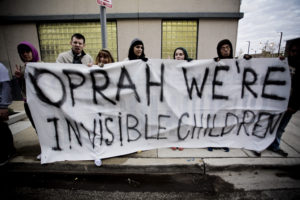Regardless of the politics of the film and the organisation (I’m not going to pretend to know enough about Uganda’s on-ground situation and its politics to make a call on whether Invisible Children’s strategy and politics is right or not.), I’d put the viral success of their recent film and related campaigning down to two things 1) a clear demonstration of the injustice and bearing witness to it, and 2) their use of all the best mobilisation/campaign-communication tricks in the book, many of which we heard at the Greenpeace DMS last week!
- The movie opens by appealing to the values of the audience (people, specifically American people, on Facebook/the internet that crave belonging, connection, and purpose) as well as universal values such as family and parenthood).
- Storytelling (in the Jonah Sachs style) in which the central character is ‘you’, the individual audience member watching the film. It doesn’t portray the narrator as ‘the hero’ but the mentor, and it invites people to be part of ‘the experiment’. It includes a clear participatory-democratic analysis: politics won’t change unless you do it yourself.
- The story itself tells of the entry path into activism, the struggles of past activism, and demonstrates the work that they have already done ‘on the ground’, to build credibility of the messenger. It is abundantly clear that this is an on-ground activist effort, with strong on-line storytelling, networking, and tactics to support the change in the ‘real world’.
- It explains the (multi-strand) strategy in detail. “We want X, so we need to do Y. To do Y, we need you to do Z.” It treats the audience with respect, like they are smart and they want to understand the strategy, rather than writing them off and simply telling them “Do Z to Stop Kony” – which would have missed so many steps in the middle that cognitive dissonance would be a huge barrier to action.
- A simple menu of actions that you can take now (including an offline action: the action kit) and I can only assume that there is a long-term engagement pathway that includes training/activist development, so that the most interested/energetic people who sign up will have a chance to come to trainings to become public speakers and citizen lobbyists. Interesting to note that people are only asked to give their Postal Code along with their email address – indicating a strong online-offline connection and hinting at local events coming later.
This post was contributed by Anna Keenan, Movement Building/Climate and Energy Campaigner at Greenpeace International.
Categories:
narrative, framing and storytelling

